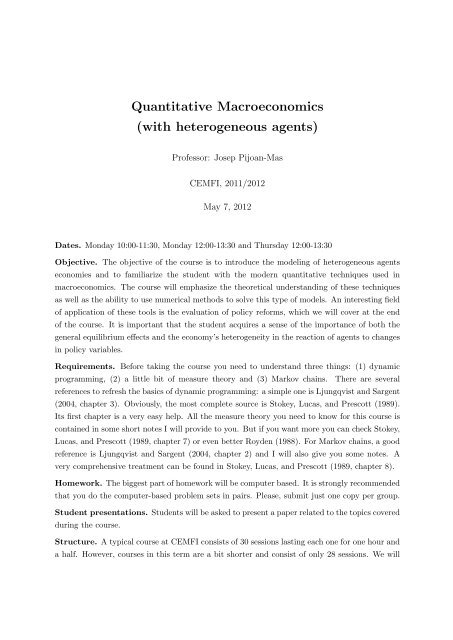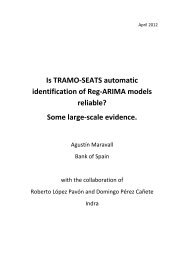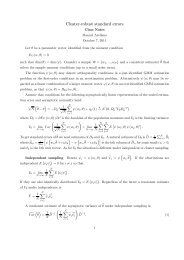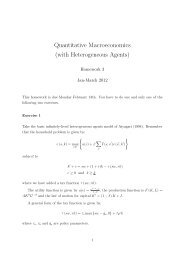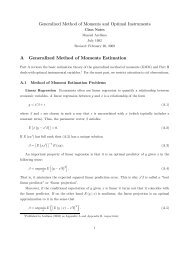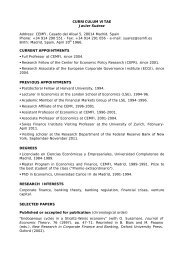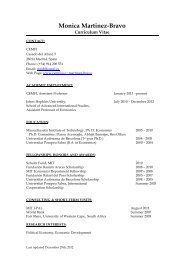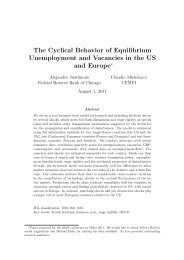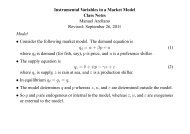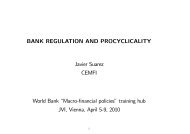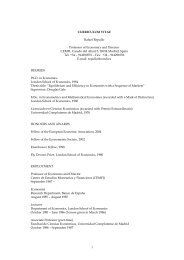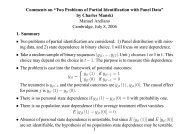Quantitative Macroeconomics (with heterogeneous agents) - Cemfi
Quantitative Macroeconomics (with heterogeneous agents) - Cemfi
Quantitative Macroeconomics (with heterogeneous agents) - Cemfi
You also want an ePaper? Increase the reach of your titles
YUMPU automatically turns print PDFs into web optimized ePapers that Google loves.
<strong>Quantitative</strong> <strong>Macroeconomics</strong> (<strong>with</strong> <strong>heterogeneous</strong> <strong>agents</strong>) Version: May 7, 2012Part IV. Policy reform evaluation.Estimated duration: 3 theory sessions1. Fundamental tax reforms• The progressivity of the income tax.Conesa and Krueger (2006)• Capital taxation and redistribution.Domeij and Heathcote (2004)• Optimal capital and income taxConesa, Kitao, and Krueger (2009)2. Social security reforms• Steady state comparisons.Storesletten, Telmer, and Yaron (1999)• The sustainability of the Social Security in Spain.Díaz-Giménez and Díaz-Saavedra (2009)• The value of the Social Security life annuity.Hong and Ríos-Rull (2007)Part V. Endogenous earnings inequality.Estimated duration: 2 theory sessions1. Back to data: heterogenity in income growth:Guvenen (2009), Guvenen (2007) and Guvenen and Smith (2009)2. Human capital accumulation as a source of heterogenous income growth:• Explaining the age profile of the income distribution:Huggett, Ventura, and Yaron (2006) and Huggett, Ventura, and Yaron (2011)• Progressive income taxes and human capital accumulation: cross-country differencesGuvenen, Kuruşçu, and Ozkan (2009)6
<strong>Quantitative</strong> <strong>Macroeconomics</strong> (<strong>with</strong> <strong>heterogeneous</strong> <strong>agents</strong>) Version: May 7, 2012Part VI. Endogenous market incompleteness.Estimated duration: 3 theory sessions1. Dynamic contracts and partial insurance.A textbook exposition (which I will not follow) can be found in Ljungqvist and Sargent(2004, chapter 20)• Public insurance may crowd-out private insurance.Attanasio and Ríos-Rull (2000)• Some empirical evidence in developing economies.Attanasio and Albarran (2002)2. Models <strong>with</strong> default.• Accounting for default in consumer credit in the U.S.:Chatterjee, Corbae, Nakajima, and Ríos-Rull (2007)• Accounting for default in sovereign debt:Arellano (2008)3. The diverging trends of income and consumption inequality.Krueger and Perri (2006), Athreya, Tam, and Young (2009) and Heathcote, Storesletten,and Violante (2008)Part VII. Other topics.Estimated duration: ??• The rise in female labor supply. Attanasio, Low, and Sánchez-Marcos (2008)• Portfolio choice along the life cycle. Cocco, Gomes, and Maenhout (2005)• The housing market and the home buying decisions. Chambers, Garriga, and Schlagenhauf(2009) and Guler (2008)• Firm size and policy distortions. Guner, Ventura, and Yi (2008)• Human capital and cross-county TFP differences: Erosa, Koreshkova, and Restuccia (2010)7
<strong>Quantitative</strong> <strong>Macroeconomics</strong> (<strong>with</strong> <strong>heterogeneous</strong> <strong>agents</strong>) Version: May 7, 2012ReferencesAdda, J., and R. Cooper (2003): Dynamic Economics. The MIT Press, Cambridge, Massachusetts.Aiyagari, S. R. (1994): “Uninsured Idiosyncratic Risk, and Aggregate Saving,” QuarterlyJournal of Economics, 109(3), 659–684.Arellano, C. (2008): “Default Risk and Income Fluctuations in Emerging Economies,” AmericanEconomic Review, 98(3), 690–712.Athreya, K., X. Tam, and E. Young (2009): “Unsecured Credit Markets Are Not InsuranceMarkets,” Journal of Monetary Economics, 56, 83–103.Attanasio, O., H. Low, and V. Sánchez-Marcos (2008): “Explaining Changes in FemaleLabor Supply in a Life-cycle Model,” American Economic Review, 98(4), 1517–1542.Attanasio, O., and J.-V. Ríos-Rull (2000): “Consumption smoothing in island economies:Can public insurance reduce welfare ?,” European Economic Review, 44, 1225–58.Attanasio, O. P., and P. Albarran (2002): “Empirical Implications of Limited Commitment.Evidence from Mexican Villages,” Mimeo.Brock, W., and L. Mirman (1972): “Optmal Economic Growth and Uncertainty: the DiscountedCase,” Journal of Economic Theory, 3(4), 497–513.Budría, S., J. Díaz-Giménez, V. Quadrini, and J.-V. Ríos-Rull (2002): “New Facts onthe U.S. Distribution of Earnings, Income and Wealth,” Federal Reserve Bank of MinneapolisQuarterly Review, 26(3), 2–35.Cagetti, M., and M. D. Nardi (2006): “Entrepreneurship, Frictions, and Wealth,” Journalof Political Economy, 114(5), 835–869.Castañeda, A., J. Díaz-Giménez, and J.-V. Ríos-Rull (2003): “Accounting for U.S.Earnigns and Wealth Inequaltiy,” Journal of Political Economy, 111(4), 818–857.Chambers, M., C. Garriga, and D. Schlagenhauf (2009): “Accounting for Changes inthe Homeownership Rate,” Forthcoming in International Economic Review.Chatterjee, S., D. Corbae, M. Nakajima, and J.-V. Ríos-Rull (2007): “A <strong>Quantitative</strong>Theory of Unsecured Consumer Credit <strong>with</strong> Risk of Default,” Econometrica, 75, 1528–1589.Cocco, J., F. Gomes, and P. Maenhout (2005): “Consumption and Portfolio Choice overthe Life Cycle,” Review of Financial Studies, 18(2), 491–533.Conesa, J. C., S. Kitao, and D. Krueger (2009): “Taxing Capital? Not a Bad Idea AfterAll!,” American Economic Review, 99, 25–48.8
<strong>Quantitative</strong> <strong>Macroeconomics</strong> (<strong>with</strong> <strong>heterogeneous</strong> <strong>agents</strong>) Version: May 7, 2012Conesa, J. C., and D. Krueger (2006): “On the Optimal Progressivity of the Income TaxCode,” Journal of Monetary Economics, 53(7), 1425–1450.Cooley, T. F., and E. C. Prescott (1995): “Economic Growth and Business Cycles,” inFrontiers of Business Cycle Research, ed. by T. F. Cooley, chap. 1. Princeton University Press,Princeton.Dávila, J., H. Hong, P. Krusell, and V. Ríos-Rull (2007): “Constrained Efficiency inthe Neoclassical Growth Model <strong>with</strong> Uninsurable Idiosyncratic Shocks,” Mimeo.De Nardi, M. (2004): “Wealth Inequality and Intergenerational Links,” Review of EconomicStudies, 71, 743–768.Díaz-Giménez, J., and J. Díaz-Saavedra (2009): “Delaying Retirement in Spain,” Reviewof Economic Dynamics, 12, 147–167.Domeij, D., and J. Heathcote (2004): “On The Distributional Effects Of Reducing CapitalTaxes,” International Economic Review, 45(2), 523–554.Erosa, A., T. Koreshkova, and D. Restuccia (2010): “How Important is Human Capital?A <strong>Quantitative</strong> Theory Assessment of World Income Inequality,” Review of Economic Studies,77(4), 1421–1449.Guler, B. (2008): “Innovations in Information Technology and the Mortgage Market,” Mimeo.Guner, N., G. Ventura, and X. Yi (2008): “Macroeconomic Implications of Size-DependentPolicies,” Review of Economic Dynamics, 11(4), 724–744.Guvenen, F. (2007): “Learning Your Earning: Are Labor Income Shocks Really Very Persistent?,”American Economic Review, 97(3), 687–712.(2009): “An Empirical Investigation of Labor Income Processes,” Review of EconomicDynamics, 12(1), 58–79.Guvenen, F., B. Kuruşçu, and S. Ozkan (2009): “Taxation of Human Capital and WageInequality: A Cross-Country Analysis,” Federal Reserve Bank of Minneapolis Staff Report438.Guvenen, F., and A. Smith (2009): “Inferring Labor Income Risk From Economic Choices:An Indirect Inference Approach,” Unpublished manuscript.Heathcote, J., F. Perri, and G. Violante (2010): “Unequal We Stand: An EmpiricalAnalysis of Economic Inequality in the United States, 1967- 2006,” Review of EconomicDynamics, 1(13), 15–51.Heathcote, J., K. Storesletten, and G. Violante (2008): “The Macroeconomic Implicationsof Rising Wage Inequality in the US,” Mimeo, New York University.9
<strong>Quantitative</strong> <strong>Macroeconomics</strong> (<strong>with</strong> <strong>heterogeneous</strong> <strong>agents</strong>) Version: May 7, 2012Heer, B., and A. Maussner (2009): Dynamic General Equilibrium Modeling. Springer.Hong, J. H., and J.-V. Ríos-Rull (2007): “Social security, life insurance and annuities forfamilies,” Journal of Monetary Economics, 54(1), 118–140.Huggett, M. (1993): “The Risk Free Rate in Heterogeneous-Agents, Incomplete InsuranceEconomies,” Journal of Economic Dynamics and Control, 17(5/6), 953–970.(1996): “Wealth Distribution in Life-Cycle Economies,” Journal of Monetary Economics,38(3), 469–494.Huggett, M., G. Ventura, and A. Yaron (2006): “Human Capital and Earnings DistributionDynamics,” Journal of Monetary Economics, 53(2), 265–290.2954.(2011): “Sources of Lifetime Inequality,” American Economic Review, 101(7), 2923–Judd, K. L. (1992): “Projection Methods for Solving Aggregate Growth Models,” Journal ofEconomic Theory, 58, 410:452.(1998): Numerical Methods in Economics. The MIT Press, Cambridge, Massachusetts.Kaplan, G., and G. Violante (2010): “How Much Consumption Insurance Beyond Self-Insurance?,” American Economic Journal: <strong>Macroeconomics</strong>, 2(4), 53–87.Krueger, D., and F. Perri (2006): “Does Income Inequality Lead to Consumption Inequality?Evidence and Theory,” Review of Economic Studies, 73(1), 163–193.Krueger, D., F. Perri, L. Pistaferri, and G. Violante (2010): “Cross Sectional Factsfor Macroeconomists,” Review of Economic Dynamics, 13(1), 1–14.Krusell, P., and A. Smith (1998): “Income and Wealth Heterogeneity in the Macroeconomy,”Journal of Political Economy, 106(5), 867–896.(2006): “<strong>Quantitative</strong> Macroeconomic Models <strong>with</strong> Heterogeneous Agents,” in Advancesin Economics and Econometrics: Theory and Applications, Ninth World Congress,ed. by R. Blundell, W. Newey, and T. Persson. Cambridge University Press, London.Ljungqvist, L., and T. Sargent (2004): Recursive Macroeconomic Theory. The MIT Press,Cambridge, Massachusetts, Second Edition.Marimon, R., and A. Scott (1999): Computational Methods for the Study of DynamicEconomies. Oxford University Press, Cambridge, Massachusetts.McGrattan, E. R. (1998): “Application of Weighted Residual Methods to Dynamic EconomicModels,” in Computational Methods for the Study of Dynamic Economics, ed. by R. Marimon,and A. Scott, chap. 6. Oxford University Press.10
<strong>Quantitative</strong> <strong>Macroeconomics</strong> (<strong>with</strong> <strong>heterogeneous</strong> <strong>agents</strong>) Version: May 7, 2012Pijoan-Mas, J. (2006): “Precautionary Savings or Working Longer Hours?,” Review of EconomicDynamics, 9, 326–352.Ríos-Rull, J.-V. (1998): “Computing Equilibria in Models <strong>with</strong> Heterogenous Agents,” inComputational Methods for the Study of Dynamic Economics, ed. by R. Marimon, andA. Scott, chap. 9. Oxford University Press.Royden, H. (1988): Real Analysis. Prentice Hall, Third Edition.Stokey, N. L., R. E. Lucas, and E. C. Prescott (1989): Recursive Methods in EconomicDynamics. Harvard University Press.Storesletten, K., C. Telmer, and A. Yaron (1999): “The Risk Sharing Implications ofAlternative Social Security Arrangements,” Carnegie-Rochester Series on Public Policy, 50,213–259.(2001): “How Important Are Idiosyncratic Shocks? Evidence from Labor Supply,”American Economic Review Papers and Procedings, 91(2), 413–17.(2004): “Consumption and Risk Sharing over the Life Cycle,” Journal of MonetaryEconomics, 51(3), 609–633.11


